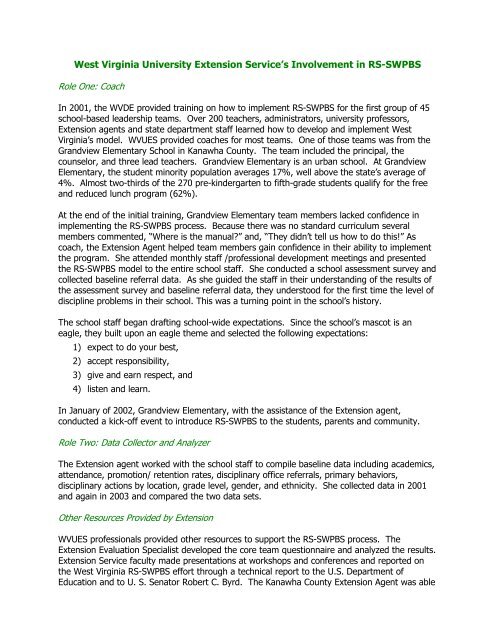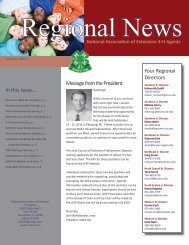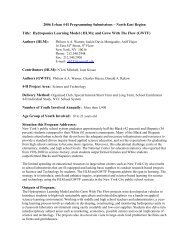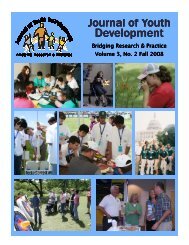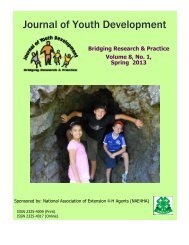Winter 2008 - Vol. 3 No. 3 - National Association of Extension 4-H ...
Winter 2008 - Vol. 3 No. 3 - National Association of Extension 4-H ...
Winter 2008 - Vol. 3 No. 3 - National Association of Extension 4-H ...
- No tags were found...
Create successful ePaper yourself
Turn your PDF publications into a flip-book with our unique Google optimized e-Paper software.
West Virginia University <strong>Extension</strong> Service’s Involvement in RS-SWPBSRole One: CoachIn 2001, the WVDE provided training on how to implement RS-SWPBS for the first group <strong>of</strong> 45school-based leadership teams. Over 200 teachers, administrators, university pr<strong>of</strong>essors,<strong>Extension</strong> agents and state department staff learned how to develop and implement WestVirginia’s model. WVUES provided coaches for most teams. One <strong>of</strong> those teams was from theGrandview Elementary School in Kanawha County. The team included the principal, thecounselor, and three lead teachers. Grandview Elementary is an urban school. At GrandviewElementary, the student minority population averages 17%, well above the state’s average <strong>of</strong>4%. Almost two-thirds <strong>of</strong> the 270 pre-kindergarten to fifth-grade students qualify for the freeand reduced lunch program (62%).At the end <strong>of</strong> the initial training, Grandview Elementary team members lacked confidence inimplementing the RS-SWPBS process. Because there was no standard curriculum severalmembers commented, “Where is the manual?” and, “They didn’t tell us how to do this!” Ascoach, the <strong>Extension</strong> Agent helped team members gain confidence in their ability to implementthe program. She attended monthly staff /pr<strong>of</strong>essional development meetings and presentedthe RS-SWPBS model to the entire school staff. She conducted a school assessment survey andcollected baseline referral data. As she guided the staff in their understanding <strong>of</strong> the results <strong>of</strong>the assessment survey and baseline referral data, they understood for the first time the level <strong>of</strong>discipline problems in their school. This was a turning point in the school’s history.The school staff began drafting school-wide expectations. Since the school’s mascot is aneagle, they built upon an eagle theme and selected the following expectations:1) expect to do your best,2) accept responsibility,3) give and earn respect, and4) listen and learn.In January <strong>of</strong> 2002, Grandview Elementary, with the assistance <strong>of</strong> the <strong>Extension</strong> agent,conducted a kick-<strong>of</strong>f event to introduce RS-SWPBS to the students, parents and community.Role Two: Data Collector and AnalyzerThe <strong>Extension</strong> agent worked with the school staff to compile baseline data including academics,attendance, promotion/ retention rates, disciplinary <strong>of</strong>fice referrals, primary behaviors,disciplinary actions by location, grade level, gender, and ethnicity. She collected data in 2001and again in 2003 and compared the two data sets.Other Resources Provided by <strong>Extension</strong>WVUES pr<strong>of</strong>essionals provided other resources to support the RS-SWPBS process. The<strong>Extension</strong> Evaluation Specialist developed the core team questionnaire and analyzed the results.<strong>Extension</strong> Service faculty made presentations at workshops and conferences and reported onthe West Virginia RS-SWPBS effort through a technical report to the U.S. Department <strong>of</strong>Education and to U. S. Senator Robert C. Byrd. The Kanawha County <strong>Extension</strong> Agent was able


